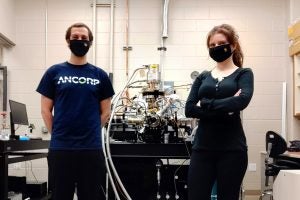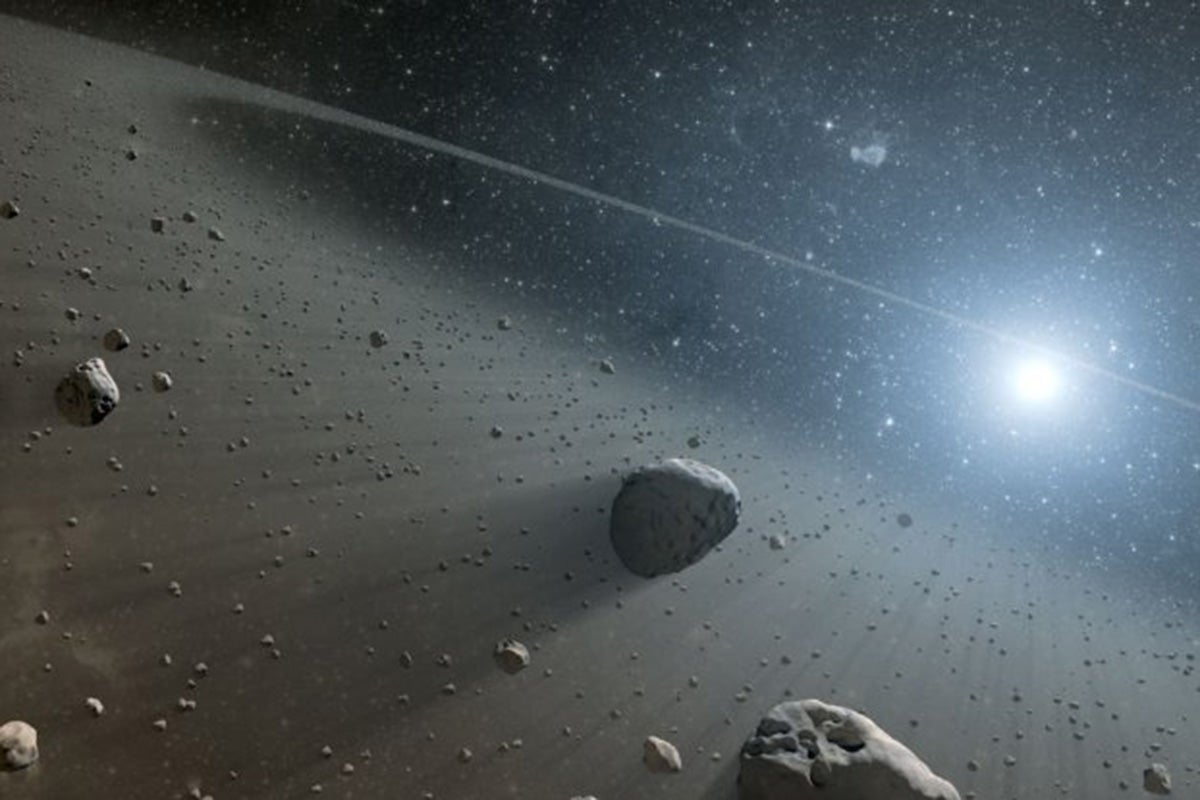Two UCF physics students just landed two NASA awards that are giving the pair the opportunity to recreate the harsh cosmic conditions found on asteroids and comets in a lab at UCF.
Brian Ferrari ’18 and Katie Slavicinska are doctoral candidates in the Astrochemistry Lab working under Assistant Professor Christopher Bennett. They met in the lab and share a passion about space research. Their close relationship also allowed them to strategize about how to best go after a NASA FINESST grant and a NASA Fellowship to make their experiment a reality.
“We talked about how me receiving the fellowship and Katie receiving FINESST would be the best possible outcome, but it was not statistically likely,” Ferrari says.
But that’s exactly what happened.
Ferrari received a three-year, $165,000 NASA OSE Fellowship and is studying the effects of irradiation on ices made from commonly found molecules in space, including water, methane, ammonia, methanol and carbon dioxide. These “astrophysically relevant ices” often form around dust grains floating in space and can become the starting material of solar systems. Simulating the conditions of space using a vacuum chamber in the lab allows Ferrari and other researchers to analyze the changes these chemicals undergo in a controlled setting.
The objective is to better understand why organic molecules like amino acids — the building blocks of proteins — appear on bodies in space that serve as carriers of these ices. An answer to that question opens up an entire new line of inquiry about the origin of life on Earth.
This fellowship will also support an annual trip to the NASA Ames Research Center in California’s Silicon Valley.
Slavicinska received a $135,000 NASA FINESST Grant, which also funds three years of research. Her work is related, but it takes a different approach to understanding the characteristics of so-called airless bodies, or bodies in space without an atmosphere.
Airless bodies like asteroids do not have atmospheres or magnetospheres to shield them from bombardment by galactic cosmic rays, solar wind particles and micrometeorite impacts. This constant “space weathering” can significantly change the surfaces of asteroids. Such changes caused by space weathering are especially poorly understood in carbon-rich asteroids, the type of asteroids on which molecules like amino acids are found, because a high carbon content makes asteroids dark and unreflective. That hampers astronomers’ ability to study the wavelengths of light reflected by the asteroid — one of the most common methods for determining an airless body’s composition.

Slavicinska will be simulating space weathering on carbon-rich meteorite and regolith simulant samples in the laboratory, allowing systematic analysis of the samples’ characteristics before, during and after weathering with multiple analytical techniques. Her studies of these carbon-rich bodies are especially timely as NASA’s OSIRIS-Rex mission prepares to collect sample from Bennu, a carbon-rich asteroid, later this month.
Ferrari came to UCF for his undergraduate degree since it was close to home and allowed him to stay near all his friends, but he stayed at UCF for his graduate degree because of his love for working for Bennett and doing astrochemistry research in his lab.
Slavicinska came to UCF because a graduate student she worked with at her undergraduate institution recommended she look into Bennett’s lab for graduate school, as it closely aligned with Slavicinska’s interests in astrochemistry, astrobiology, and developing instrumentation.
The Lab group, which also includes undergraduate students Sarah Swiersz, Remi Cantelas and Riley Havel, uses experimental and theoretical methods to investigate the physical, chemical and biochemical processes that could occur in various astrochemical and planetary environments.
The FINESST recipients were announced first.
“It was bittersweet; I was happy that Katie got the grant but sad I didn’t,” Ferrari says.
However, Slavicinska says she held out hope and believed Ferrari would end up receiving the fellowship, which was announced a couple of weeks later. Both Slavicinska and Ferrari point to their grants as something that has brought them even closer together as a couple.
“Our dynamic is productive, but fun,” Slavicinska says. “We are both very passionate about our research, so it’s convenient having each other around so much to discuss what’s going on in each other’s projects and develop new ideas together.”
Ferrari has a physics degree with a minor in mathematics from UCF and joined Bennett’s lab in 2016. Slavicinska has a chemistry degree with a minor in physics from Kennesaw State University and joined the lab in 2019.




